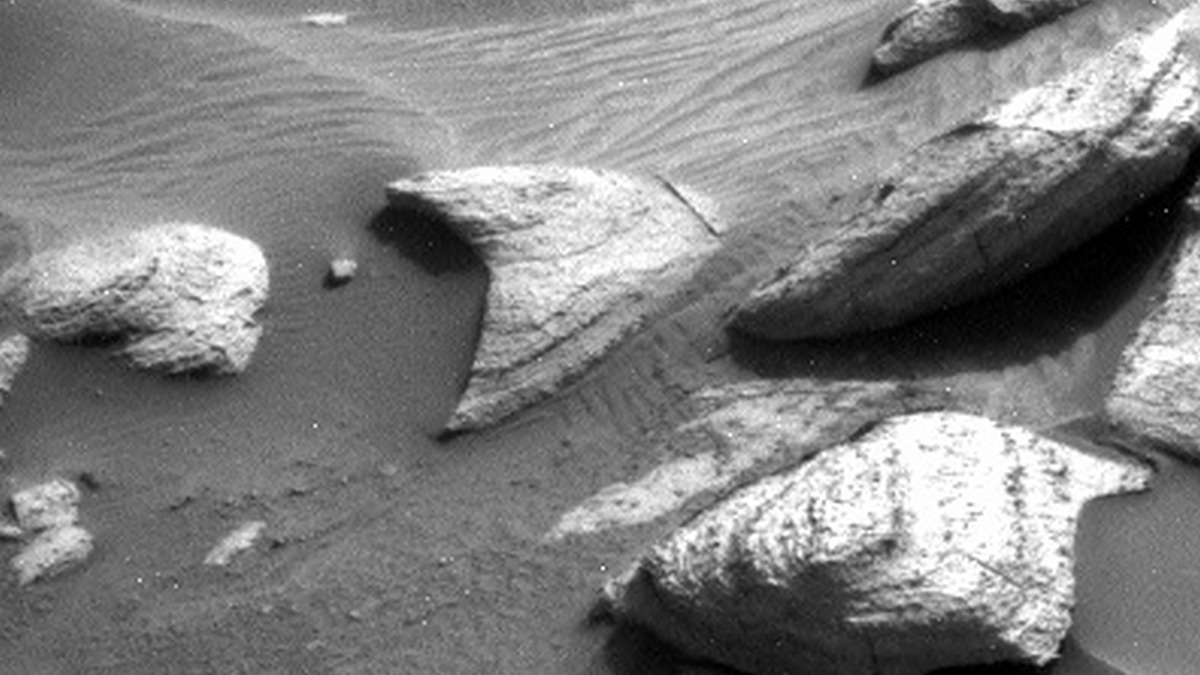'Star Trek' on Mars? Curiosity rover spots Starfleet symbol on Red Planet

Did someone leave a communicator badge lying on Mars?
NASA's long-running Curiosity rover mission just spotted a familiar shape to "Star Trek" fans: The iconic delta-shaped emblem that Starfleet officers typically wear on their uniforms. Unfortunately, it would be highly illogical to say that a Starfleet landing party walked near Curiosity's roving grounds, as the image was of a mere Mars rock that just so happens to resemble the "Star Trek" symbol.
The image was originally posted on the Mars Curiosity raw images site provided by NASA's Jet Propulsion Laboratory (JPL). It was taken with the rover's left navigation camera on Mars day, or sol, 4062 of the mission on Jan. 9.
Amateur astronomer Scott Atkinson spotted the Trekkie symbol and joked about it on X, formerly Twitter. "I bet the Star Trek fans on the @MarsCuriosity team smiled like Cheshire Cats when they saw this new image appear on their screens," Atkinson posted on Jan. 10, alongside the image and a close-up of the delta sign.
Related: NASA spacecraft spots 'Star Trek' logo on Mars
Curiosity landed on Mars on Aug. 5, 2012 and continues to roll on in its long-standing search for the conditions of life on the Red Planet. As a part of that long mission, it is climbing a mountain nicknamed Mount Sharp (or Aeolis Mons) and peering at the layers embedded in it to see how water flowed in the ancient past of Mars.
"Different layers of Mount Sharp represent different eras of Martian history. As Curiosity ascends, scientists learn more about how the landscape changed over time," JPL officials wrote in September 2023. The rover is now in a zone that is filled with sulfate, the statement added, "which may be the highest elevation layer it will ever visit."
Breaking space news, the latest updates on rocket launches, skywatching events and more!
I bet the Star Trek fans on the @MarsCuriosity team smiled like Cheshire Cats when they saw this new image appear on their screens... :-)Image Credit: NASA/JPL-Caltech pic.twitter.com/SdWyq4Sc5PJanuary 10, 2024
Curiosity took the pictures while it was about to do "contact science on a flat block of dark-toned bedrock", according to a Jan. 9 update on the mission's blog. One of its near-term goals will be to examine, in the rocks, "composition and texture of the dark bands we've been observing from orbit" using several instruments.
The success of Curiosity at Gale Crater allowed NASA to send a follow-up rover mission, Perseverance, to the Red Planet's Jezero Crater in 2020. Perseverance is hunting for signs of ancient Red Planet life.
NASA is also planning a Mars sample return mission that should bring back caches of rocks that Perseverance is laying aside, but funding and technology issues will likely push back its expected 2031 return date.

Elizabeth Howell (she/her), Ph.D., was a staff writer in the spaceflight channel between 2022 and 2024 specializing in Canadian space news. She was contributing writer for Space.com for 10 years from 2012 to 2024. Elizabeth's reporting includes multiple exclusives with the White House, leading world coverage about a lost-and-found space tomato on the International Space Station, witnessing five human spaceflight launches on two continents, flying parabolic, working inside a spacesuit, and participating in a simulated Mars mission. Her latest book, "Why Am I Taller?" (ECW Press, 2022) is co-written with astronaut Dave Williams.

